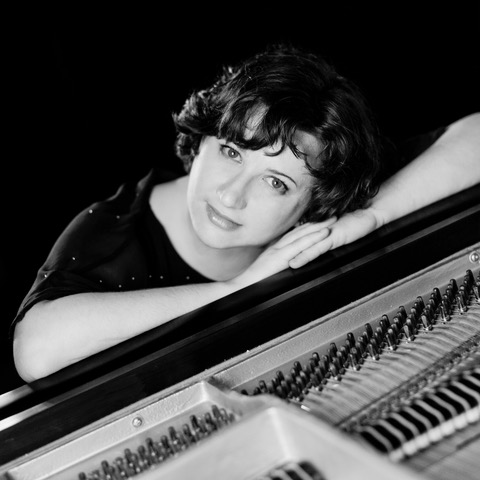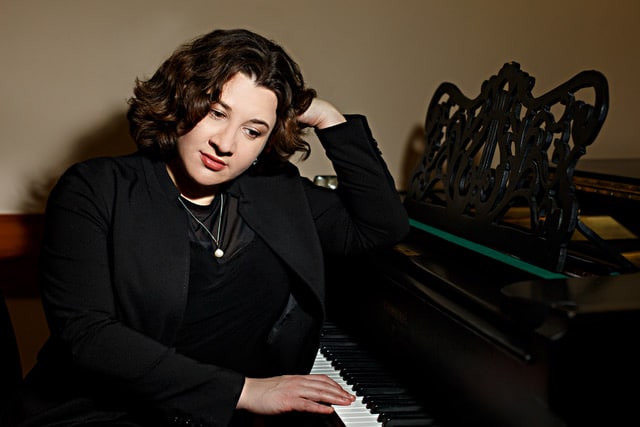The growth of public interest in performance of music in the 19th century meant many socially relevant things. The patronage system was over, and the public was necessary to support artists. A new competiveness emerged, and the ability to astound became critical. “In short, the age of the globe-trotting virtuoso was born. We are still living it” (Taruskin & Gibbs).
Clara Schumann: Variations on a Theme by Robert Schumann, Op. 20
Clara Wieck Schumann (1819-1896) was a phenomenal pianist, a treasured virtuoso in 19th century Europe. “…This girl, born in an age when musical talent in a female was regarded only as an asset in the marriage market, subsequently built a glorious career that spanned sixty years” (Nancy Reich). She was born in Leipzig in a household fraught with tension and discord. Clara’s response to the dysfunctional household was that she didn’t speak a single word until she was over four years old. Called selective mutism, this complex anxiety disorder affected her profoundly. She found respite and peace at the piano, immersed in music. In 1837, at only 18, Clara arrived in Vienna to give a series of solo recitals. By the fourth concert she was recalled to the stage thirteen times by wild applause. A cake was even named after her! Over her career, Clara played recitals in the Gewandhaus in Leipzig on 74 occasions, more than any other artist of her generation. She always played from memory, a practice which actually earned her some criticism. At that time, it was the practice to use the composer’s score– anything else was seen as arrogance.
Clara married Robert Schumann the day before her 21st birthday. She was a world-renowned artist, however most people had never heard of her husband. Over the next sixteen years she gave birth to eight children, one of whom died in infancy. She was pregnant for at least a portion of every year for 14 years. By age 37 she was a widow with seven children. After her husband’s death, Clara continued to concertize, always dressing in black in Robert’s memory.
Clara completed all 66 of her compositions before Robert Schumann’s death in 1856, save one small march. Today’s work from 1853 was presented to Robert for his birthday, the last he was to spend with his family. Robert’s mental illness was seriously debilitating him and she was pregnant with Felix, her youngest child. To imagine the stresses on her is mindboggling. The hauntingly beautiful theme is from Robert’s Op. 99, No. 4 (Bunte Blätter). Clara adds seven variations and a coda.
Robert Schumann: Allegro, Op 8
Robert Schumann (1810-1856) composed this piece in 1831 just after he had left university law studies. He began formal piano studies with Friedrich Wieck (Clara’s father) and moved into the family’s home. Robert believed at this point that he would become a world famous concert pianist. Alas, that was just prior to ruining his hand with a homemade device that was meant to strengthen his fingers. Living in the Wieck household simultaneously was Ernestine von Fricken. Ernestine and Robert struck up an amorous relationship. In his diary, Schumann reveals that he had been advised by his physician to find a wife in order to recover completely from a previous nervous breakdown (some might argue that a wife could cause a nervous breakdown, but never mind). He thought Ernestine might be just the wife he needed. Though he gave her a ring, their engagement was kept quiet. After Ernestine returned to her home, the relationship eventually ended. This Allegro is dedicated to her.
This piece demands a virtuoso’s technique. It opens with a cadenza-like passage which leads into the main theme, a dotted rhythmic figure which propels the piece forward. The contrasting second theme is more lyrical, yet is still tied to the rhythmic gestures of the opening. The harmonic language of this piece is wide-ranging, a characteristic of Schumann’s style to come. Brilliant arpeggios conclude the piece. It is dynamic, compelling, and demanding.
Franz Liszt: Transcendental Etude No. 12, Chasse-Neige (Snow-Whirls)*
Franz Liszt (1811-1886) was in Paris in 1831, the year that Robert Schumann composed Op. 8. He heard the incredible violinist Niccolo Paganini (1782-1840) perform for the first time and it changed his musical life. Paganini was THE virtuoso of the day. Some believed that the only way he could pull off such virtuosity was that he was in league with the devil. “Rumour had it that his fourth string … was made from the intestine of his mistress, whom he had murdered with his own hands” (Alan Walker). Paganini “created and solved his own technical problems”. After Liszt saw him perform, he decided to transfer some of the feats he’d observed to the piano. Liszt had composed a first version of the twelve Transcendental Etudes in 1824 when he was 13, but after he heard Paganini he revised them into pieces of staggering difficulty. When Robert Schumann first saw a copy, he wrote that they were “studies in storm and dread for, at the most, ten or twelve players in the world.”
This last of the twelve etudes incorporates many difficulties. Tremolo chords, controlled voicings, large leaps, and fast scales are required. The brilliance of Liszt is that he incorporates fantastic compositional expertise with amazing virtuosity. This piece is not for the faint of heart and we are incredibly fortunate to hear Ms. Gulyak perform it for us today. Her interpretation is sensitive and controlled, very powerful.
Liszt became a rock star after these pieces were introduced. Michael Jackson and The Beatles had nothing on Liszt. His portrait was worn on brooches and cameos; swooning ladies attempted to take cuttings of his hair; they stormed the piano to grab the broken strings and make them into bracelets; some wore little vials that contained his coffee dregs. Ladies fought over his silk handkerchiefs and velvet gloves, often ripping them to pieces for souvenirs. Others collected his cigar butts, which they tucked in their cleavages. (See Alan Walker’s Franz Liszt, the Virtuoso Years).
* The contemporary translation of “chasse-neige” is snow plow. Apparently Liszt was a prophet in more ways than one.
Johannes Brahms: Klavierstücke op.119
In 1890 Johannes Brahms (1833-1897) pondered retirement from composition. He wrote to a friend that he “had achieved enough; here I had before me a carefree old age and could enjoy it in peace” (Jan Swafford, 1999). However, he became reinvigorated by the famous clarinetist, Richard Muhlfeld, and continued composing for the remainder of his life. Several stunning works appeared. Thankfully for pianists, Op. 119 was among them. Upon receiving this set from Brahms (1833-1896), Clara Schumann wrote in her diary: “It really is marvelous how things pour from him; it is wonderful how he combines passion and tenderness in the smallest of spaces.” “Passion and tenderness” describe these introspective pieces well. They represent the entire range of emotions from despondency through joy. Brahms wrote the pieces on a summer holiday in 1893 at Bad Ischl, a spa town in northern Austria where he summered for the last eight years of his life. Brahms was sixty years old when he wrote Op. 119.
The first Intermezzo in B minor is a serious work, described by Brahms as “melancholy”. The second Intermezzo exhibits a transformation of the opening agitated theme into a songlike section (which may remind you of the early Brahms waltz, Op. 39, No. 2). The third Intermezzo is a cheerful and lighthearted work in C major. The concluding Rhapsody is triumphant, vibrant and complicated. A peaceful inner section is short-lived, and the work ends with a dazzling coda.
At this point, someone better deliver a power smoothie to our artist.
Sergei Rachmaninoff: Variations on a Theme by Corelli op.42
Sergei Rachmaninoff (1873-1943) wrote this set of variations in 1931 in Clairefontaine, France,
after he had emigrated from Russia. It was his first solo piano composition since he had left his homeland in 1917 and the last before his death in 1943. In 1934 Rachmaninoff wrote: “For when I left Russia, I left behind me my desire to compose: losing my country I lost myself also. To the exile whose musical roots, traditions and background have been annihilated, there remains no desire for self-expression.” The theme itself is a 16th century folk melody called “La Folia” (“Madness”) which Corelli used for a violin sonata. This set of 20 variations and a coda are extremely difficult and complex. Melancholy and solemn, Vladimir Ashkenazy described the work as a “sea of gloom and darkness”.
Interestingly, Rachmaninoff didn’t seem to trust his own work. In a letter to his friend Nikolai Medtner he wrote: “I’ve played the Variations about fifteen times, but of these fifteen performances only one was good. The others were sloppy. I can’t play my own compositions! And it’s so boring! Not once have I played these all in continuity. I was guided by the coughing of the audience. Whenever the coughing would increase, I would skip the next variation. Whenever there was no coughing, I would play them in proper order. In one concert, I don’t remember where – some small town – the coughing was so violent that I played only ten variations (out of 20). My best record was set in New York, where I played 18 variations. However, I hope that you will play all of them, and won’t ‘cough'” (Bertensson, A Lifetime in Music).
Ruth Howell, music critic of the Washington Daily News (Nov. 6, 1931) seemed to agree with the composer’s self-review. “There were, perhaps, too many variations. The piece grew long, boring, and the theme thickened so that even Corelli couldn’t have found it. If the finale had been put in five minutes before, it would have been perfect. When it was finished, even Rachmaninoff looked a little disgusted”. In spite of such misgivings, this is a fabulous piece with intricate rhythms and harmonies. The variations are not traditionally bound, but rather unfold as a metamorphosis of the original theme.
Alexander Scriabin: Vers la flamme op.72
Alexander Scriabin (1872-1915) wrote this piece in 1914. Originally intended to become his eleventh sonata, he published it alone because he was in dire financial straits. The title of this extremely difficult piece (“towards the flame”) gives us a specific reference to fire. The fire in this case, however, is not just any run-of-the-mill fire–this is THE fire—the one which will destroy the world, providing change and transformation, or in Scriabin’s view, enlightenment. Scriabin believed that “a constant accumulation of heat would ultimately cause the destruction of the world”. “Vers la flame presents a huge tension that is only released at the end. Fire and light are depicted in the tremolandos with fanfares elsewhere” (James Kreiling).
Don’t be alarmed if you find yourself seeing colors during this performance. Scriabin had synesthesia, a condition which creates a blending of senses–tasting words or smelling shapes, for example. In Scriabin’s case, he saw very clear colors when he heard specific musical pitches. D was bright yellow, A was dark green, and D-flat was dark purple.
Igor Stravinsky/Guido Agosti : The Firebird
Igor Stravinsky (1882-1971) wrote this orchestral work for Sergei Diaghilev’s dance company in 1910 in Paris. Diaghilev had asked him to write music based on the Russian folk tale. The tale is the story of Prince Ivan and his encounters with the Firebird, a magical creature with vibrant, shimmering plumage. Prince Ivan captures her in his net, but spares her. In her gratitude the Firebird gives him a magic feather to be used in times of danger. The feather itself represents beauty, magic, and rebirth. After several harrowing adventures, the Prince marries a beautiful princess and it is a fairy-tale ending–they live happily ever after. At its premiere The Firebird was a dazzling success. When this ballet was first performed in America, the set and costumes were designed by the famous artist, Marc Chagall.
In 1928, Guido Agosti (1901-1989) an Italian pianist, transcribed three movements for piano solo. For clarity’s sake, most of the piece is arranged on three staves rather than the customary two. Keep in mind that the lone pianist is covering what an entire orchestra of around 66 players does normally. You will not be surprised by this point in our concert to discover that this piece requires several unroped ascents of Mt Everest and K2 by the pianist. Hang on to your hats, and don’t look down.
In the Danse infernale Prince Ivan is abducted by the evil Katschei and his minions. Prince Ivan uses his feather to cast a spell on his captors, making them dance until they drop from exhaustion. The Berceuse depicts the eerie scene of the sleeping kidnappers, which leads to the Finale, a wedding celebration when Prince Ivan marries the most beautiful princess in the entire kingdom.
@ Copyright Diane Baxter 2023





